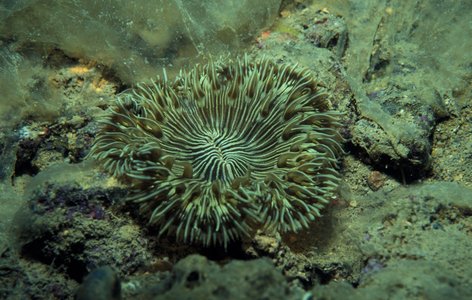Cereus
Actinia pedunculatus
Characteristics
Sagartiidae with well developed base. Column with cinclides and verrucae capable of attaching foreign bodies to themselves. Margin tentaculate. Sphincter well developed, mesogloeal. Tentacles fairly short, hexamerously arranged, extraordinarily numerous, their longitudinal muscles ectodermal. Oral disc more or less undulate. Two siphonoglyphs. Mesenteries hexamerously arranged, more numerous distally than proximally. More than 12 pairs of perfect mesenteries. Retractors of mesenteries fairly restricted, band-like. All stronger mesenteries fertile. Cnidom: spirocysts, basitrichs, microbasic p-mastigophors, microbasic amastigophors.References
Carlgren, O. 1949. A Survey of the Ptychodactiaria, Corallimorpharia and Actiniaria. Kungl. Svenska Vetenskapsakadamiens Handlingar, series 4, volume 1, number 1.
Title Illustrations

| Scientific Name | Cereus pedunculatus |
|---|---|
| Location | Adriatic Sea |
| Specimen Condition | Live Specimen |
| Identified By | Oscar Ocana from collected specimens |
| Copyright |
© Peter Wirtz

|
About This Page
The information provided on this page is based on Oscar Carlgren's 1949 catalog.Copyright © 1949 Swedish Academy of Sciences.
Please note that Carlgren's text contains a number of errors, and much of the information is now out of date. An update of the catalog is currently under preparation in Daphne Fautin's laboratory, and the results of this work will be incorporated in future versions of this page.
Keyboarding of Carlgren's catalog was done as part of a project to create an electronic database of the sea anemones of the world, funded by NSF Grant DEB9521819, awarded to Daphne G. Fautin. This grant is in the program Partnerships to Enhance Expertise in Taxonomy (PEET). Susanne Hauswaldt, Katherine Pearson, and April Wakefield-Pagels contributed to the keyboarding effort.
Correspondence regarding this page should be directed to Daphne G. Fautin at
Page copyright © 2000
All Rights Reserved.
Citing this page:
Tree of Life Web Project. 2000. Cereus. Actinia pedunculatus . Version 01 January 2000 (temporary). http://tolweb.org/Actinia_pedunculatus/18298/2000.01.01 in The Tree of Life Web Project, http://tolweb.org/








 Go to quick links
Go to quick search
Go to navigation for this section of the ToL site
Go to detailed links for the ToL site
Go to quick links
Go to quick search
Go to navigation for this section of the ToL site
Go to detailed links for the ToL site